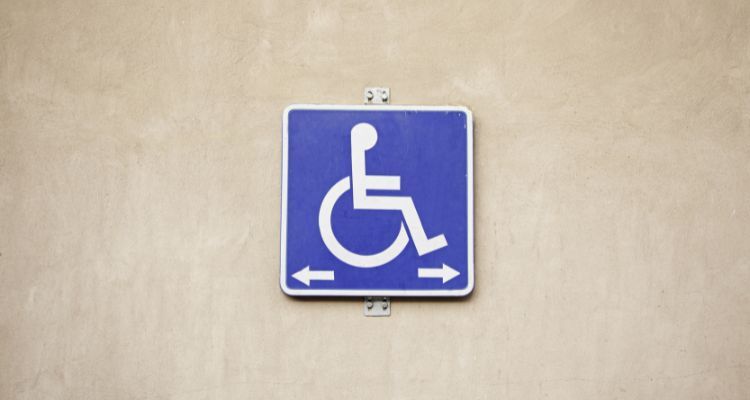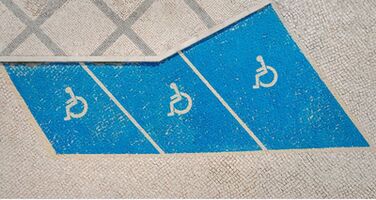
Tips for Displaying Your Handicap Placard Correctly in South Dakota
For individuals with disabilities, having a disability tag (also known as a placard) is an essential tool that provides access to designated accessible parking spaces, which are usually located near building entrances. In SD, a disability tag ensures that people with mobility impairments or other qualifying conditions can park in spaces that allow for easier access to public and private facilities. However, to take full advantage of the privileges provided by your disability tag, it is crucial to display it correctly and follow the state’s regulations.
Improper display or misuse of a disability tag can lead to fines, revocation of privileges, or frustration when parking in designated spaces. This article will guide you through the correct way to display your handicap placard in South Dakota, ensuring you remain compliant with state laws and avoid common mistakes. We will also cover the application process, including how to get a disability tag through HandicapMD.com, and answer frequently asked questions (FAQs) to address common concerns.
What Is a Handicap Placard and Why Is It Important?
Purpose and Benefits of a Disability Tag
A disability tag (or placard) is a special parking permit issued by the South Dakota Department of Public Safety to individuals who have qualifying medical conditions or disabilities that impair their ability to walk or require the use of assistive devices. These tags allow individuals to park in designated accessible spaces, which are often located closer to building entrances and provide extra space for mobility devices like wheelchairs, walkers, or crutches.
Disability tags are essential for providing greater mobility, convenience, and safety to people with disabilities. They ensure that individuals have access to public spaces without the added burden of navigating long distances across parking lots. The tags are also valid in many other states, making it easier for individuals to travel while still having access to accessible handicap parking.
Types of Disability Tags Available in South Dakota
In SD, there are three main types of handicap permits:
Permanent Disability Tag: This is issued to individuals with permanent disabilities. It is valid for five years and can be renewed.
Temporary Disability Tag: Issued to individuals with temporary conditions, such as those recovering from surgery or injury, these tags are valid for up to six months. They are non-renewable, but another can be issued if the medical condition persists.
Disability License Plate: This plate is issued for vehicles owned by individuals with disabilities. It serves the same function as a tag but is affixed to the vehicle, so it doesn't need to be transferred between vehicles.
Both tags offer the same parking privileges, but their duration of validity differs depending on the nature of the disability. Once you’ve been issued a disability tag, the next step is ensuring that you use it correctly by following SD’s guidelines for display.
How to Apply for a Handicap Placard in South Dakota
Applying for a South Dakota handicap placard is a straightforward process, and you can choose between obtaining your tag through the state's DMV or via HandicapMD.com, an online platform that simplifies the medical certification process for disability parking permits.
Application Process Overview
To apply for a disability tag in SD, you will need to:
Complete an Application Form: The Application for Disability Placard (Form MV-044) can be downloaded from the state's Department of Public Safety website or picked up at a local DMV office.
Obtain Medical Certification: A licensed HandicapMD healthcare provider must certify that you meet the eligibility criteria for a disability pass. The healthcare provider must fill out the medical certification section of the application.
Submit the Application: You can submit your completed application form, along with the required medical certification, in person or by mail to the state's DMV.
Applying for a Disability Tag through HandicapMD.com
For those who prefer an easier and faster way to complete the medical certification process, HandicapMD.com provides a convenient solution. Here’s how it works:
Visit HandicapMD.com: Begin the application process by visiting HandicapMD.com, where you can complete an online questionnaire about your medical condition.
Consult with a Licensed Physician: HandicapMD.com connects you with a licensed physician who will review your condition and provide the necessary medical certification for your disability pass.
Receive Your Certification: Once your physician approves your condition, you will receive the certified documents needed to apply for a disability pass in SD.
Submit the Documents to the DMV: After receiving the medical certification from HandicapMD.com, you can submit the completed documents to the state's DMV to receive your disability tag.
This process allows you to obtain medical certification without needing an in-person visit to your physician, making it ideal for individuals who prefer a more streamlined approach.
Required Documents and Medical Certification
To apply for a disability tag in SD, you will need:
- A completed Application for Disability Placard (Form MV-044).
- Medical certification from a licensed healthcare provider (or through HandicapMD.com).
- Proof of identity, such as a South Dakota driver’s license or state ID card.
Temporary vs. Permanent Tags
- Permanent Disability Tags: Issued for long-term disabilities and are valid for five years.
- Temporary Disability Tags: Issued for short-term disabilities, valid for up to six months, and renewable with updated medical certification.
Key Rules and Regulations
The most important aspect of using a disability tag in SD is ensuring that it is displayed correctly. Failure to do so can result in fines, even if you have a valid tag or plate. Additionally, it’s crucial to remember that these permits are assigned to the person with the disability, not the vehicle. This means that you cannot use the tag if the individual it was issued for is not present in the car.
Tips for Displaying Your Handicap Placard Correctly in South Dakota
Displaying your handicap placard properly is essential to avoid fines and to ensure that you continue to enjoy the benefits of accessible parking. Here are some tips to help you display your tag correctly in SD:
1. Hang the Tag from the Rearview Mirror
In SD, disability tags must be hung from the rearview mirror of your vehicle whenever you are parked in a designated accessible parking space. The tag should be placed on the mirror so that it is clearly visible from outside the vehicle. This allows parking enforcement officers to see the permit number and expiration date without having to enter your vehicle.
Tip: Ensure that the tag is not obstructed by other items hanging from the mirror, as this could make it difficult for parking authorities to view the details on the tag. Remove the tag from the rearview mirror when driving. SD law prohibits any objects that obstruct the driver’s view, and a hanging tag can impair your vision.
2. Ensure the Information is Clearly Visible and Readable
When hanging your disability tag, make sure that the front of the tag is facing outward, toward the windshield. The permit number and expiration date must be easily visible to avoid misunderstandings or fines. If the information on your tag is faded or worn, you may need to request a replacement.
Tip: If your rearview mirror is obstructed (for example, in a vehicle that doesn't have one), you can place the tag on the dashboard, but it must be clearly visible and not obstructed by any objects. Sometimes, glare from the sun or clutter on the dashboard can obscure the tag, so make sure it’s fully visible.
3. Remove the Tag When Driving
SD law requires that the disability tag must be removed from the rearview mirror while driving. This is important for safety reasons, as leaving the tag in place while driving can obstruct your view of the road and create a potential hazard. Make it a habit to remove the tag before starting your car, and rehang it when you park in an accessible space.
4. Use the Tag Only When the Permit Holder is Present
A disability tag is issued specifically to the individual with the qualifying disability, not to the vehicle. This means that the tag can only be used when the authorized holder is either driving or riding in the vehicle. It is illegal to let others use your disability tag when you are not present, and doing so can result in fines or the revocation of your parking privileges.
Tip: You cannot use the tag to park in accessible spaces if the person with the disability is not in the car. Misuse of the tag can result in revocation of the tag and fines.
5. Check for Expiration and Renew On Time
Disability tags in SD have an expiration date, which is printed on the front of the tag. Be sure to check your tag regularly to ensure it has not expired. Permanent tags are valid for five years, while temporary tags are valid for up to six months. Renew your tag before it expires to avoid losing your parking privileges.
Tip: Ensure that your tag is not expired. If it is, you may receive a fine for parking in a handicapped space with an invalid tag. Mark the expiration date on your calendar and set a reminder to renew your tag. SD does not provide automatic reminders, so it’s up to you to ensure your tag remains valid.
6. Ensure the License Plate is Properly Installed
For individuals with disability license plates, the plate must be installed properly on the vehicle and visible to enforcement officers. If you change vehicles, make sure to transfer the plate correctly and legally.
Tip: Ensure your license plate is always clean and readable. Over time, plates can wear down and become difficult to read, which may result in parking violations.
7. Do Not Park in Unauthorized Areas
Having a disability tag or license plate does not give you the right to park in restricted or unauthorized areas. This includes loading zones, fire lanes, or spaces reserved for other specific purposes.
Tip: Pay attention to signage and parking restrictions, even in areas with accessible spaces. Having a disability tag does not exempt you from obeying local parking regulations.
8. Replace Damaged or Faded Placards
Over time, disability tags can become damaged or faded, making them difficult to read. If your tag is no longer legible, it’s important to request a replacement from the South Dakota Department of Public Safety.
Tip: Don’t delay in requesting a replacement if your tag becomes damaged. Faded or damaged tags may result in a ticket for improper display.
9. Do Not Park in Unauthorized Areas
Having a disability tag or license plate does not give you the right to park in restricted or unauthorized areas. This includes loading zones, fire lanes, or spaces reserved for other specific purposes.
Tip: Pay attention to signage and parking restrictions, even in areas with accessible spaces. Having a disability tag does not exempt you from obeying local parking regulations.
10. Display the Placard on Your Dashboard If Necessary
If your vehicle doesn’t have a rearview mirror or if hanging the tag from the mirror isn’t practical, SD law allows you to place the tag on your dashboard. However, it must still be fully visible, and the permit number and expiration date must be readable from outside the vehicle.
Tip: Use a tag holder or protective sleeve if you need to place it on the dashboard. This will help prevent the tag from sliding around or getting obscured by other items.
Common Mistakes to Avoid When Using a Disabled Permit
While using a disability tag offers significant benefits, improper use can lead to penalties. Here are some common mistakes to avoid:
1. Forgetting to Display the Tag
One of the most common mistakes is forgetting to hang the disability tag from the rearview mirror when parking in an accessible space. Even if you are eligible to use the space, failure to display the tag can result in a parking ticket.
Solution: Make it a habit to always hang your tag when you park, and ensure it is easily visible from outside the vehicle.
2. Using an Expired Tag
Using an expired disability tag is illegal, even if you still qualify for accessible parking. Always check the expiration date on your tag and apply for a renewal before it expires.
Solution: Set a reminder on your phone or calendar to renew your tag before the expiration date.
3. Letting Others Use Your Tag Without You Present
Allowing someone else to use your disability tag when you are not present is a violation of SD law. Disability tags are issued to individuals based on their medical condition, and they are non-transferable.
Solution: Ensure that the tag is used only when you, the authorized holder, are either driving or a passenger in the vehicle.
Frequently Asked Questions (FAQs)
1. How long is a disability tag valid in SD?
- Permanent disability tags are valid for five years and must be renewed before the expiration date.
- Temporary disability tags are valid for up to six months and can be renewed with updated medical certification if necessary.
2. Can I use my SD disability tag in other states?
Yes, SD disability tags are recognized in other U.S. states under the Americans with Disabilities Act (ADA). You can use your tag to park in designated accessible spaces when traveling, but be sure to check local regulations regarding parking time limits and fees.
3. What should I do if my disability tag is lost or stolen?
If your disability tag is lost or stolen, you should contact the state's DMV to request a replacement. You may need to provide proof of identity and explain the circumstances of the loss or theft.
4. Can someone else use my disability tag?
No, disability tags are issued to the individual with the qualifying disability, and they are non-transferable. The tag can only be used when the authorized holder is present in the vehicle, either as the driver or a passenger.
5. How do I renew my disability tag in SD?
To renew a permanent disability pass, submit a renewal application to the state's DMV before your pass expires. No new medical certification is needed unless your condition has changed. For temporary tags, you will need updated medical certification if your condition persists.
Conclusion
Displaying your handicap placard correctly in South Dakota is essential to ensure that you enjoy the full benefits of accessible parking without facing fines or penalties. By following the tips outlined in this article—such as hanging your tag from the rearview mirror, removing it while driving, and renewing it before it expires—you can avoid common mistakes and ensure compliance with South Dakota laws.
Additionally, if you are applying for a disability tag for the first time, consider using HandicapMD.com for a fast and convenient way to obtain medical certification. Whether you need a temporary or permanent tag, HandicapMD.com simplifies the process, allowing you to focus on what matters most: maintaining your independence and mobility.
With proper use, your disability tag will provide you with easier access to public spaces, safer parking options, and peace of mind as you navigate daily life.
.png)






